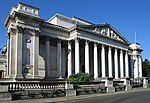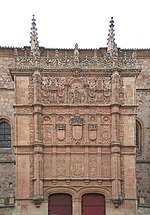The Vision of Fray Lauterio is an oil on canvas painting by Bartolomé Esteban Murillo, from c. 1640. It is held in the Fitzwilliam Museum, in Cambridge...
2 KB (120 words) - 01:13, 9 August 2023
Panis angelicus (category Eucharist in the Catholic Church)
Corpus Christi as part of a complete liturgy of the feast, including prayers for the Mass and the Liturgy of the Hours. The strophe of "Sacris solemniis"...
4 KB (407 words) - 12:54, 2 September 2023
the essence of an object, literally its "whatness" or "what it is". The term "quiddity" derives from the Latin word quidditas, which was used by the medieval...
3 KB (387 words) - 13:33, 13 November 2024
The Summa contra Gentiles is one of the best-known treatises by Thomas Aquinas, written as four books between 1259 and 1265. Whereas the Summa Theologiæ...
16 KB (2,139 words) - 20:47, 4 October 2024
The principle of double effect – also known as the rule of double effect, the doctrine of double effect, often abbreviated as DDE or PDE, double-effect...
6 KB (785 words) - 07:45, 13 November 2024
Fitzwilliam Museum (redirect from The Fitzwilliam Museum)
Constable, Murillo (The Vision of Fray Lauterio), and Renoir. It also has extensive works by J. M. W. Turner, which has its origins in a set of 25 watercolour...
26 KB (2,432 words) - 14:43, 19 November 2024
from the Peripatetic school of Greek philosophy, established by Aristotle in his Lyceum in ancient Athens. Aquinas argued that the existence of God could...
2 KB (177 words) - 15:34, 25 October 2024
Thomas Aquinas (redirect from The Angelic Doctor)
achieved through the beatific vision, in which a person experiences perfect, unending happiness by seeing the essence of God. The vision occurs after death...
148 KB (17,800 words) - 03:58, 21 November 2024
concupiscence is the tendency of humans to sin. There are nine occurrences of concupiscence in the Douay-Rheims Bible and three occurrences in the King James...
11 KB (1,291 words) - 23:42, 21 October 2024
Cardinal virtues (category Pages using sidebar with the child parameter)
The cardinal virtues are four virtues of mind and character in classical philosophy. They are prudence, justice, fortitude, and temperance. They form a...
27 KB (3,067 words) - 00:15, 13 November 2024
philosophical movement which promotes the interchange of ideas between the thought of Thomas Aquinas (including the philosophy carried on in relation to...
9 KB (1,087 words) - 21:01, 27 August 2024
Hylomorphism (category Philosophy of Aristotle)
doctrine developed by the Ancient Greek philosopher Aristotle, which conceives every physical entity or being (ousia) as a compound of matter (potency) and...
31 KB (4,258 words) - 16:30, 1 October 2024
Five Ways (Aquinas) (category Arguments for the existence of God)
Uses of Language, Eucharistic Identity, and the 'Baptist' Vision. Authentic Media. ISBN 9781842278666. James, Aaron B. (2014). Analogous Uses of Language...
36 KB (4,656 words) - 21:10, 8 November 2024
reconcile the liberty or free will of humans with divine omniscience. In 1582 the Jesuit Prudencio Montemayor and Fray Luis de León spoke publicly about...
48 KB (6,177 words) - 06:29, 11 November 2024
Actus purus (category Articles incorporating a citation from the 1913 Catholic Encyclopedia with Wikisource reference)
philosophy, Actus Purus (Latin for 'Pure Actuality' / 'Pure Act') is the absolute perfection of God. Created beings have potentiality that is not actuality, imperfections...
6 KB (804 words) - 05:56, 22 October 2024
Thomism (category Articles incorporating a citation from the 1913 Catholic Encyclopedia with Wikisource reference)
earth; only at the beatific vision. Notably, man cannot attain true happiness without God. Regarding emotion (used synonymously with the word "passion"...
118 KB (13,534 words) - 21:11, 17 November 2024
Treatise on Law (category Philosophy of law)
Aquinas' major work of legal philosophy. It forms questions 90–108 of the Prima Secundæ ("First [Part] of the Second [Part]") of the Summa Theologiæ, Aquinas'...
11 KB (1,541 words) - 16:57, 2 September 2024
The Vision of Saint Anthony of Padua is a 1656 oil on canvas painting by Bartolomé Esteban Murillo, commissioned by the chapter of Seville Cathedral as...
3 KB (276 words) - 01:14, 2 May 2024
The Little Fruitseller is a c.1670-1675 oil on canvas painting by Bartolomé Esteban Murillo, held in the Alte Pinakothek in Munich, to which it was bequeathed...
967 bytes (46 words) - 22:18, 7 August 2023
Bartolomé Esteban Murillo (category Wikipedia articles incorporating a citation from the 1911 Encyclopaedia Britannica with Wikisource reference)
the characteristic elements of Murillo’s work are already evident: the elegance and beauty of the female figures and the angels, the realism of the still-life...
20 KB (2,017 words) - 22:05, 21 November 2024
The just price is a theory of ethics in economics that attempts to set standards of fairness in transactions. With intellectual roots in ancient Greek...
12 KB (1,541 words) - 17:20, 6 November 2024
Summa Theologica (category Literature of the Dominican Order)
the object of the vision and, at the same time, causes the vision. The perfection of the blessed also demands that the body be restored to the soul as something...
58 KB (7,717 words) - 03:45, 21 November 2024
of philosophy. He is known for being an early theorist in the field of semiotics. Born of noble parentage to a Spanish mother and a father likely of Belgian...
9 KB (871 words) - 09:58, 2 November 2024
Divine simplicity (redirect from Simplicity of God)
In classical theistic and monotheistic theology, the doctrine of divine simplicity says that God is simple (without parts). God exists as one unified...
39 KB (4,514 words) - 05:11, 5 November 2024
Quaestiones Disputatae de Veritate (category CS1 maint: DOI inactive as of November 2024)
collection of questions that are discussed in the disputation style of medieval scholasticism. It covers a variety of topics centering on the true, the good...
14 KB (1,831 words) - 13:45, 2 November 2024
Réginald Garrigou-Lagrange (category Academic staff of the Pontifical University of Saint Thomas Aquinas)
Martin Grabmann as distinguished theologians of the 20th century. As professor at the Pontifical University of Saint Thomas Aquinas, he taught dogmatic and...
27 KB (2,772 words) - 04:16, 5 November 2024
the basis for the doctrine of justification in the Roman Catholic Church and is rooted in the theology of Thomas Aquinas and Augustine of Hippo. The doctrine...
3 KB (269 words) - 22:35, 6 November 2023
Sacris solemniis (category Eucharist in the Catholic Church)
the feast of Corpus Christi (also known as the Solemnity of the Holy Body and Blood of Christ). The strophe of Sacris solemniis that begins with the words...
6 KB (364 words) - 01:51, 22 November 2024
The Apparition of the Virgin to Saint Bernard is an oil on canvas painting by Spanish artist Bartolomé Esteban Murillo, created c. 1655, now held in the...
4 KB (416 words) - 07:25, 28 September 2024
Thomistic sacramental theology (redirect from Aquinas and the sacraments)
theology of the sacraments of the Catholic Church. It can be found through his writings in the 13th-century works Summa contra Gentiles and in the Summa...
4 KB (501 words) - 13:05, 29 April 2023
















